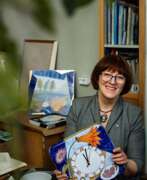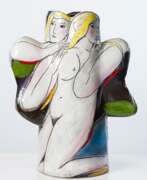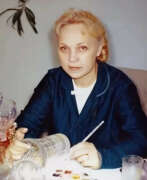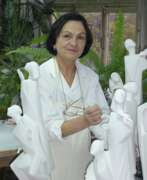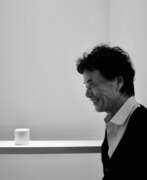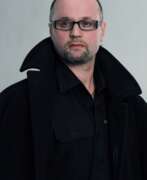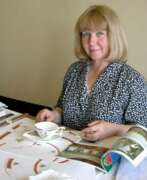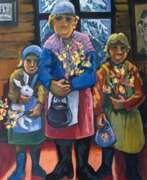Ceramists 21st century


Yō Akiyama (秋山 陽) is a Japanese ceramicist based in Kyoto. He was a late leading figure of Sōdeisha, a twentieth-century avant-garde artist group that sought to redefine understandings of aesthetics and purpose in modern and contemporary ceramics, focusing on sculptural attributes over strict functionality. Akiyama studied directly under Kazuo Yagi, one of the founders of Sōdeisha, for six years. Akiyama later became a professor at Kyoto Municipal University of Arts and Music, where he is currently a Professor Emeritus, having retired in 2018. As an artist, he works primarily with black pottery, a technique that fires clay in low temp, smoky conditions to create a dark effect. His predominantly largescale work is richly textural and abstract, emphasizing the earthy materiality of the work as well as its form.


Frederico Aguilar Alcuaz is a Filipino abstract painter, sculptor and ceramist, and master tapestry artist.
He studied painting at the University of the Philippines' School of Fine Arts, then lived and worked both in the Philippines and Spain, and in Brno, Czech Republic, he worked extensively on tapestries.
Alcuaz has earned international acclaim with his vivid abstract works in various genres and techniques, and he has exhibited extensively internationally.
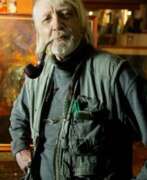

David Fielding Gough Boyd was an Australian artist, and a member of the Boyd artistic dynasty.
In 1946, he worked with his brother Guy at the Martin Boyd Pottery in Sydney. He also established a pottery studio in London in the early 1950s and continued working mainly in pottery through to the mid-1960s. In 1956, Boyd and his wife became widely known as leading Australian potters. They introduced new glazing techniques and potter's wheel use in shaping sculptural figures.
Boyd's painting career began in 1957 with a series of symbolic paintings on Australian explorers that aroused much controversy at the time, focusing as they did on the tragic history of the Aboriginal Tasmanians. In 1958 he exhibited a series of paintings based on the histological episodes in the explorations of Burke and wills and Bass and Flinders.[3] He joined the Antipodeans Group in the 1950s. Boyd discovered a technique in 1966 that he named Sfumato, after da Vinci's usage of the word to describe graduations of smoky tones in painting. Boyd's method achieved this effect through a new technique involving candle flame.


Peter Brandes is a Danish painter, sculptor, ceramic artist and photographer.
Brandes' art is abstract and often in brown colours. He had his breakthrough as artist in the beginning of the 1980s. He has, inter alia, done artwork on Roskilde Domkirke and mosaic (colored glass) windows in a church at Nordkap and the church Village of Hope, south of Los Angeles. In 1998, he created the enormous Roskilde Jars which stand outside the main Roskilde Railway Station.
Brandes is self-taught and his art circles around themes from Christianity. Ancient Greek mythology has also inspired his art. Brandes has illustrated a number of books, for example Homer’s Iliad. A great part of Brandes' ceramic works are inspired by ancient Greek art and mythology.


Roger Capron, birth name Roger Henri Louis Capron, is a French ceramic sculptor and draftsman.
Capron studied applied arts in Paris and in 1946 founded a pottery workshop, l'Atelier Callis, in Vallauris, employing up to 120 people at various times. Capron won many awards, including the Grand Prix International de la Céramique in 1970, and in 1983 he founded the now famous Atelier Capron.
Roger Capron's creations often use clay tiles or enameled lava tiles, traditionally used for decorative panels. This recognizable way of using ceramics in furniture and objects has become the designer's trademark. Capron was the first to put his ceramic expertise at the service of semi-industrial production. The workshop developed into a small factory and gained an international reputation.


Mario Ceroli is an Italian sculptor. His work has been exhibited at the Museum of Modern Art in New York City and the Mississippi Museum of Art in Jackson, Mississippi. One of his sculptures is on the Luigi Einaudi campus of the University of Turin, and another one is at the Vatican Museums.


Dieter Crumbiegel is a German painter-painter and ceramist.
He studied ceramics at the Academy of Fine Arts in Kassel and opened his own studio in Fulda in 1964. Dieter Crumbiegel's paintings, on the other hand, convey messages that are only revealed to him while he is painting. These works have no titles; instead, they are assigned an ordinal number.
Since 1961, Crumbiegel's works have been widely exhibited both in Germany and abroad, in Australia, Ireland, Italy, Japan, Spain and Taiwan.


Hanna Dąbkowska-Skriabin is a Polish artist.
She graduated from the Academy of Fine Arts in Warsaw in the Department of Painting.
Hanna was very concerned about the fate of the human race, which is ruining itself with greed and short-sightedness. This is reflected in the works of the artist: many of her paintings are a timeless vision of a harsh world dominated by suffering and injustice. As if to protest against all this evil, Hanna Dąbkowska-Skriabin painted both paintings about love and beautiful landscapes. She is best known for her oil paintings. She has also mastered the techniques of ceramics and tapestry.


Juan Manuel de la Rosa is a painter, engraver, and ceramicist known for his works on handmade paper. He studied lesser-known techniques for painting and papermaking from Japan, Egypt, Fiyi and France; his handmade paper is typically made of linen, cotton, or hemp. With these traditional approaches, he creates layers and adds new dimensions to his artworks.


Edmund Arthur Lowndes de Waal is a contemporary English artist, master potter and author. He is known for his large-scale installations of porcelain vessels often created in response to collections and archives or the history of a particular place. De Waal's book The Hare with Amber Eyes was awarded the Costa Book Award for Biography, Royal Society of Literature Ondaatje Prize in 2011 and Windham–Campbell Literature Prize for Non-Fiction in 2015. De Waal's second book The White Road, tracing his journey to discover the history of porcelain was released in 2015.


Klaus Eberlein was a German graphic artist, illustrator and ceramic sculptor. He initially completed training as a chromolithographer. From 1962 to 1968 he attended the Academy of Fine Arts in Munich, and from 1968 he was a master student of Hermann Kaspar, receiving a final diploma from the academy. Eberlein was a member of the Association for Original Etching, the Dachau Artists' Association and the Munich Artists' Association. In 2013 he was accepted into the South German literary association Münchner Turmschreiber.


Pierrette Favarger was a Swiss artist, renowned for her unique approach to ceramics and sculpture. Born in 1924, Favarger's work is distinguished by her refusal to use fire for baking her creations. This unusual technique allowed her to incorporate materials like textiles, feathers, fur, and even nails into her clay work, which could not withstand high temperatures. Her style, focusing on terracotta and the human figure, stood apart from contemporary trends, defying modern labels.
Throughout her career, Favarger participated in significant collective exhibitions, such as the one in Faenza in 1984, Zürich's Heimatwerk in 1986, and China in 1987. Additionally, her works were showcased in numerous solo exhibitions, including those at the Musée d'art et d'histoire de Neuchâtel in 1975 and 1999, and the Galerie Ditesheim in 1982 and 1990. Her distinctive work was again exhibited in 2020 at the Musée Ariana in the "Anatomie fragmentée" exhibition alongside pieces by Jean-Marie Borgeaud, Paul March, and Patriciu Mateescu.
Pierrette Favarger's career, marked by her innovative approach to ceramics, made a significant impact in the art world. Her works, which often challenged conventional ceramic techniques, are a testament to her creative spirit and technical mastery.
If you are a collector, auctioneer, or an expert in art and antiques, and wish to stay updated on new product sales and auction events related to Pierrette Favarger, sign up for our updates. This subscription is exclusively for alerts on new sales and events, ensuring you stay informed about the latest in this field.


Bryan Ferry is an English singer and songwriter. His voice has been described as an "elegant, seductive croon". He also established a distinctive image and sartorial style: according to The Independent, Ferry and his contemporary David Bowie influenced a generation with both their music and their appearances. Peter York described Ferry as "an art object" who "should hang in the Tate".


Elizabeth Fritsch (born 1940) is a British studio potter and ceramic artist born into a Welsh family in Whitchurch on the Shropshire border. Her innovative hand built and painted pots are often influenced by ideas from music, painting, literature, landscape and architecture.


She studied art in Japan, Spain and Germany.
Leiko Ikemura's work encompasses painting, sculpture, video and photography. She works in a variety of techniques, including oil painting, ceramic and bronze sculpture, printmaking and watercolor. She currently works in Cologne and Berlin and teaches painting at the Hochschule für Kunst in Berlin.


Élisabeth Joulia was a French ceramist. Since the 1950s, she has contributed to freeing ceramics from tradition in order to build organic forms of great sensuality that are born of her view of nature and are constantly renewed through her research and her intimate vision of the world.


Matsumaro Khan (Russian: Мацумаро Хан), also known as Victor Khan (Виктор Хан), is a Russian sculptor and media artist of Korean descent. His artistic approach is eye-catching, especially when he works with fired and heat-treated materials, which gives his work an unpredictable visual effect. For Matsumaro, fire is not only a tool but also an ally in creating unique works of art.
Tireless in his creativity, Matsumaro experiments with and is inspired by unusual objects such as mugs and pots, creating masterpieces that seem to open the door to an alien world. His work is a perfect blend of tradition and modernity, which makes his art recognizable and in demand both in Russia and abroad.


Jan Kollwitz is a German ceramic artist.
In his youth Kollwitz became interested in pottery, studying it with recognized masters Horst Kerstan and Yutaka Nakamura. In 1988, the Japanese kiln builder Tatsuo Watanabe built a traditional Japanese anagama kiln in his workshop in Sismar (Ostholstein). Since then Jan Kollwitz has been firing his ceramics here, the roots of which can be found deep in Zen Buddhism and the Japanese tea ceremony.
Since 1990, Jan Kollwitz's work has been shown in numerous exhibitions. The artist's work can be found in the Boston Museum of Fine Arts, the Museum of Asian Art in Berlin and other European museums and collections.


Beate Kuhn is a German ceramic sculptor.
She had an unprecedented influence on the development of German ceramics after the war, when in the mid-1960s she abandoned utilitarian ceramics in favor of free art.
After graduating from the Werkkunstschule in Wiesbaden, she founded her own workshop in Düdelsheim in 1957, developing a style that was already unmistakably her own. Here Beate Kuhn's sculptures were created from individual hand-carved and chiseled elements, which she assembled into a coherent whole. She transferred this stylistic principle of stringing geometric bodies to her designs of large-scale ceramic fountains. The artist's characteristic work can be found in every outstanding collection. The enormous number of prizes awarded to her underscores the recognition and appreciation she has enjoyed.


Jennifer Elizabeth Lee is a Scottish ceramic artist with an international reputation. Lee's distinctive pots are hand built using traditional pinch and coil methods. She has developed a method of colouring the pots by mixing metallic oxides into the clay before making. Her work is held in over forty museums and public collections worldwide, including The Metropolitan Museum of Art in New York, The Philadelphia Museum of Art, Los Angeles County Museum and the Victoria and Albert Museum. In 2018 Lee won the Loewe Craft Prize, an award initiated by Jonathan Anderson in 2017. The prize was presented to her at an awards ceremony at The Design Museum in London.


Dietrich Lusici, born Dietrich Schade, is a German painter, graphic and poster artist, sculptor and ceramicist.
He studied graphic design at the Technical School of Advertising and Design in Berlin, then studied at the Academy of Fine Arts in East Berlin. Lusici has created painted books and posters, does bas-reliefs and ceramics, and paints figurative paintings.




Manuel John Neri the Younger was an American sculptor who is recognized for his life-size figurative sculptures in plaster, bronze, and marble. In Neri's work with the figure, he conveys an emotional inner state that is revealed through body language and gesture. Since 1965 his studio was in Benicia, California; in 1981 he purchased a studio in Carrara, Italy, for working in marble. Over four decades, beginning in the early 1970s, Neri worked primarily with the same model, Mary Julia Klimenko, creating drawings and sculptures that merge contemporary concerns with Modernist sculptural forms.


Grayson Perry is an English contemporary artist, writer and broadcaster. He is known for his ceramic vases, tapestries, and cross-dressing, as well as his observations of the contemporary arts scene, and for dissecting British "prejudices, fashions and foibles".


Gilbert Portanier is a French artist, painter and ceramist.
He studied architecture at the Ecole des Beaux-Arts in Paris, then opened his own studio in Vallauris. Portanier is known for the variety of forms of his ceramic works, which range from the most classical and structured to the most baroque. He is often called the "wizard of colors.


